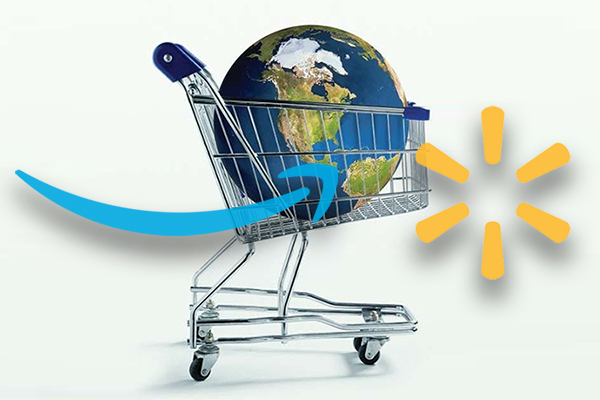The Amazon Effect is the New Walmart Effect
In 1994, Amazon.com founder Jeff Bezos read a statistic that the Internet had been growing at 2300 percent annually.
He fashioned that changing tide into a business plan that has been breaking barriers across supply chain and e-commerce that has left an indelible mark.
But, is Amazon worried about the new “Walmart effect”?
Beginning with booksellers, the e-commerce giant has expedited the closure of many retailers and threatens to redefine the standards of shopping in a digital world.
Retailers are forced to lower prices, optimize their systems and processes, and reduce profit margins in favor of competition; meanwhile, Amazon continues its trek toward dominance.
First coined in 2012 by American theoretical physicist Steven L. Weinberg, this is the Amazon Effect.
Following the 2006 book by Charles Fishman called “The Walmart Effect,” the Amazon Effect is a story of an Entrepreneur and his execution of an idea.
That execution of that idea is changing consumer habits and raising the bar for sellers.
Let’s take a closer look at the parallels between the Walmart Effect and the Amazon Effect and explore the implications for the future of online and brick-and-mortar shopping.
What Is the Walmart Effect?
It is clear that Walmart purchased Jet.com in order to compete with Amazon. This is the clearest signal that the changes in the retail market place are real and sustained.
According to the 2006 book, The Walmart effect begins with the idea of offering consumers the lowest possible price to acquire goods by leveraging large-scale purchasing power and a culture focused on cost-cutting.
Entrepreneurs and small business owners face such tremendous pressure than many of them end up insolvent. Decreased sales from price and convenience competition cause many retailers to close their doors.
Fishman argued that Walmart was so large and transformative in the way it did business that it is “beyond the market forces that capitalism relies on to enforce fair play [and] isn’t subject to the market forces because it’s creating them.”
“Walmart is now so big that it's possible to ask a whole set of questions that would have been irrelevant, if not downright silly, 20 years ago. For example, what is the impact of Walmart's wages not on its own workers, but on the wages in an entire town, or in an entire industry? What is Walmart's impact on the variety and availability of consumer goods? What is Walmart's direct impact on sending U.S. manufacturing jobs overseas? What is the impact on local economies of Walmart's abandoning old stores? What is the impact of Walmart-and its suppliers-on the environment?” Charles Fishman
Now analysts are discussing Amazon’s effect on the retail industry (the so-called “Amazon Effect”). Just like a decade ago, analysts attribute the changes in the retail marketplace to Amazon’s disruptive technology and business strategy.
What is the Amazon Effect?
The Amazon Effect has come to mean a few things. First, consumers are offered something so compelling that they shift their buying habits, which results in a reduction of sales for retailers.
Retailers respond by adjusting their sales strategies to meet the needs of the altered consumers. Unwinding overbuilt brick-and-mortar stores, enhancing the customer experience, and updating fulfillment networks and systems are slow and expensive endeavors. Retailers that are slow to respond are forced into bankruptcy.
The consumer experience is relatively un-phased as shopping options remain abundant.
Is the Amazon Effect the New Walmart Effect?
Amazon offers several ways for third-party sellers to compete but has the advantage of configuring the rules in a way in which Amazon (the business) always wins.
While third-party sellers on Amazon have wide control over pricing, it may be difficult to move more products when Amazon can achieve the same process at lower profit margins.
The game has changed and retailers, manufacturers, and sellers must respond quickly or face extinction. In essence, the Amazon Effect has become the New Walmart Effect.
What Does the Amazon Effect Mean for Retailers, Entrepreneurs, and Small-Business Owners?
In the recent book “The Amazon Marketplace Dilemma: A Brand Executive’s Challenge Growing Sales and Maintaining Control,” authors James Thomson and Joseph Hansen study dozens of strategic considerations that a brand company must evaluate in developing and implementing the right Amazon strategy.
They state that the five pillars to a foundation of strength on Amazon are: Branding, Distribution, Pricing, Product Availability, and Catalog Selection.
In June of 2017, sports apparel giant Nike announced that they will be selling their products directly on Amazon.com in order to improve the Nike consumer experience. Previously, Nike products were only available on Amazon via third-party sellers.
The same tactics used to overcome the pitfalls of the Walmart Effect, like focusing on local selling strategies, listening to consumers, and offering more than just a single product/service, can safeguard small-business owners and retailers against this threat.
Take Advantage of Lessons From the Past to Safeguard Against the Growing Power of Amazon
Amazon bears many similarities to the rise of Walmart, but it is possible to stay competitive with the online behemoth.
Protect your assets by integrating systems and driving your supply chain costs down.
If you need help determining how to use your supply chain for competitive advantage, implementing or enhancing your supply chain systems, or optimizing your existing systems to meet the needs of today’s consumers, choose an experienced partner.
Amazon Effect vs. Walmart Effect Conclusion
The lesson to be learned here is that the Amazon Effect is not new, it is merely a sooner than expected iteration of the Walmart Effect of the 1990s and 2000s.
Moreover, the market place changes pioneered by Walmart, which caused market disruption and reallocation of resources, are the same type of changes that Amazon is now ushering in. These changes can be expected to impact various sectors that depend on the traditional retail sector.
Download the White Paper: Bringing Omnichannel to the Forefront of Ecommerce
About the Author
Adam Robinson oversees the overall marketing strategy for Cerasis including website development, social media and content marketing, trade show marketing, email campaigns, and webinar marketing. Mr. Robinson works with the business development department to create messaging that attracts the right decision makers, gaining inbound leads and increasing brand awareness all while shortening sales cycles, the time it takes to gain sales appointments and set proper sales and execution expectations.
Related Article: Taking a Look at Why Amazon Is Bringing Logistics In-House
Related White Papers
Bringing Omnichannel to the Forefront of Ecommerce
This white paper is a must read for those who are looking to go omnichannel with their supply chain and want to understand that a major part of that strategy is in the ecommerce channel. Download Now!
Multichannel Fulfillment & Shipping: Streamlining Your Ecommerce Logistics Implementation Process
This white paper is a must read for those shippers of larger freight and surface freight who are wanting to open channels, such as direct to consumer by using e-commerce, beyond traditional ones. Download Now!
How Blockchain will Aid Retailers & Shippers in Achieving Omnichannel Supply Chain Goals
This educational white paper is a must-read for shippers & retailers alike to learn how blockchain can aid in achieving omnichannel supply chain goals. Download Now!
More Resources from Cerasis
Article topics
Email Sign Up

















